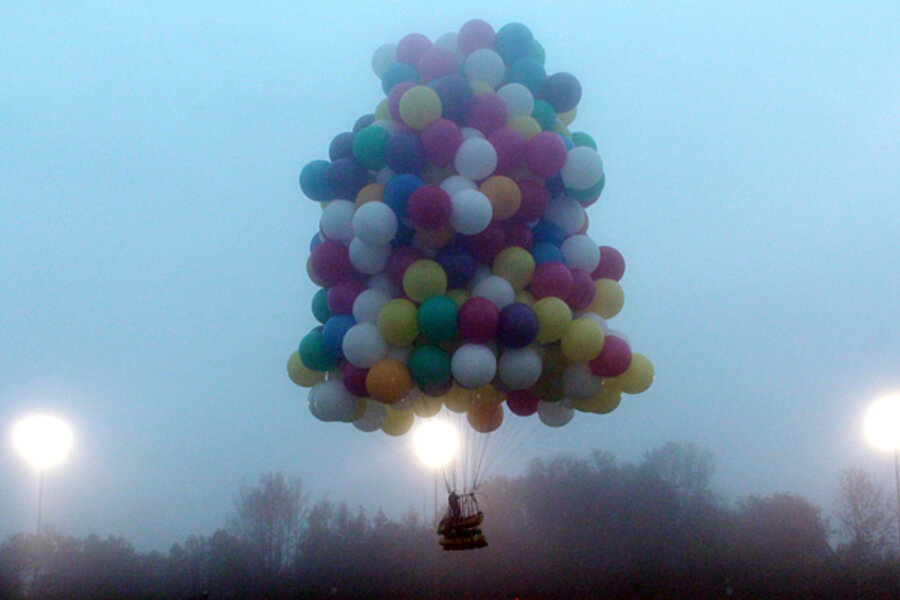Tar Heel cluster balloonist struggles to cross Atlantic, 'Up'-style
Loading...
| Atlanta
Jonathan Trappe, a Raleigh, N.C., IT guy, pilot, and the top cluster balloon explorer in the world, abandoned his attempt to ride 370 balloons of helium on “conveyor belt” winds across the Atlantic on Thursday.
“Hmm, this doesn’t look like France,” he posted on Facebook before landing in Newfoundland after 12 hours aloft. It’s unclear whether he voluntarily abandoned the attempt because of unfavorable weather or whether he was forced down. At last report, he was alive and well.
The failed attempt was likely crushing for the almost-40 explorer who has previously crossed the English Channel and the Alps using nothing but small balloons and an office chair.
Trading chairs in for a double-hulled inflatable life boat to serve as his basket, Mr. Trappe, in an online missive, listed other explorers who have sought to cross what he calls “that tremendous body of water” using only “Wind, Helium and Hope.”
Before the launch, Trappe wrote: “Two years of work, and years more of dreams. My heart could never live a long life the way it is beating now. My heart would never last to old age, the way it is beating today. We have this moment – these ephemeral hours – to stand in this aircraft and undertake the first flight of its kind, and to pursue, and to seize, and to realize the dream that has held me, and generations of dreamers, rapt for ages.”
Edgar Allan Poe was the first dreamer, in 1844, to ponder a transatlantic balloon flight, laying down a path for a succession of helium balloon explorers, the latest of which was Col. Joe Kittinger, who floated a helium balloon across the Atlantic in 1984.
While Trappe is considered a professional cluster balloonist given his pilot background, arguably the best known cluster balloon flier was an amateur, “Lawnchair” Larry Walters of California, who broke a tether on an experimental lawn-chair balloon flight in 1982, and had to use a BB gun to shoot out enough balloons to get back down – but not before climbing to 16,000 feet and, later, earning a $1,500 fine from the FAA.
But no one has so far cluster-ballooned the way Trappe planned this week: Taking a blueprint from the Pixar movie “Up,” where an aging man uses helium balloons to fly his house to South America, he sought to use small balloons, child-at-the-zoo-style, to float across the Atlantic “in God’s hand,” as balloonists frequently describe the experience.
A team waited in Caribou, Maine, near the Canadian border, for weeks in anticipation of a certain set of conditions that would clear the way for launch. The team began inflating the balloons Wednesday night as an unsteady frontal system was set to move through, clearing the way for a wind pattern that Trappe, using weather info from the same meteorologist who informed parachutist Felix Baumgartner before his sky dive from space, estimated would take him to Western Europe. Conceivably, he could’ve landed anywhere from Iceland to Morocco, or smack in the middle of the Atlantic.
Whether dream or folly, cluster ballooning poses grave dangers. In 2008, two months before Trappe made his first flight, a Catholic priest named Adelir Antonio de Carli took off from Brazil underneath 1,000 balloons. He reached an altitude of nearly 20,000 feet as he floated out across the Atlantic, never to be seen alive again. His body was recovered that summer by offshore oil workers.
"If I touch down on water then the attempt will be over as it will be impossible to take off again, but the boat will keep me alive," Trappe told London’s Guardian newspaper. "It will be incredibly dangerous as I could be several days away from any rescue crew and it will mean surviving rough seas for a long time, alone."
It’s doubtful that the failed Atlantic crossing on Thursday will deter Trappe, however, who sees himself as the scion of a “new generation” of cluster balloonists and sky explorers. He told the New York Times in 2008 that clusterballooning “represents a contrast between the normal mundane world and the world of my dreams.”








